Ann Martin: a female flogged!
Learning intention
Students are learning to:
- understand the different aspects of daily life of First Fleet convicts
- recognise the challenges of living in the new colony
- examine historical sources of information
Success criteria
Students will be successful when they can:
- describe the activities that convicts participated in
- identify forms of punishment
- explain the challenges for female convicts and children
Student Activities
Who is she?
Students meet a female convict who represents one of the unnoticed and disregarded in our colonial history.
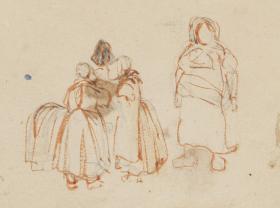
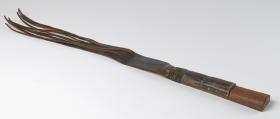
What did Ann do all day?
Students discover some of the happenings of a convict's daily life.
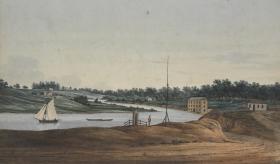
Did Ann have a family?
Students explore the hardships of everyday family life in early New South Wales.
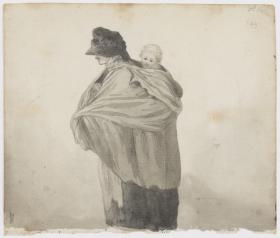
What did Ann achieve?
Students consider their own lives in the context of Ann Martin’s life.
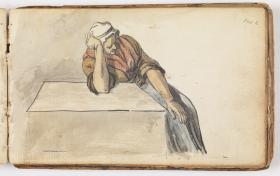
NSW Syllabus for the Australian Curriculum History K-10
HT2-3 describes people, events and actions related to world exploration and its effects
HT2-4 describes and explains effects of British colonisation in Australia
HT2-5 applies skills of historical inquiry and communication
Stories of the First Fleet, including reasons for the journey, who travelled to Australia, and their experiences following arrival (ACHHK079)
Students:
- describe the establishment of the British colony at Port Jackson
- using a range of sources, investigate the everyday life of ONE of the following who sailed on the First Fleet and lived in the early colony: a soldier, convict, ex-convict, official
Comprehension: chronology, terms and concepts:
- respond, read and write, to show understanding of historical matters
- use historical terms
Analysis and use of sources:
- locate relevant information from sources provided
Perspectives and interpretations:
- identify different points of view within an historical context
Empathetic understanding:
- explain how and why people in the past may have lived and behaved differently from today
Research:
- pose a range of questions about the past
- plan an historical inquiry
Explanation and communication:
- develop texts, particularly narratives
- use a range of communication forms (oral, graphic, written) and digital technologies
Continuity and change: changes and continuities due to British colonisation of Australia.
Cause and effect: reasons for a particular historical development
Perspectives: different points of view within an historical context
Empathetic understanding: how and why people in the past may have lived and behaved differently from today.
Significance: the importance and meaning of national commemorations and celebrations, and the importance of a person or event.
Contestability: historical events or issues may be interpreted differently by historians, eg British 'invasion' or 'settlement' of Australia.
General capabilities:
- Critical and creative thinking
- Ethical understanding
- Intercultural understanding
- Literacy
Stories of the First Fleet, including reasons for the journey, who travelled to Australia, and their experiences following arrival (ACHASSK085)
- investigating attitudes to the poor, the treatment of prisoners at that time, and the social standing of those who travelled to Australia on the First Fleet, including families, children and convict guards
- investigating daily life in the Botany Bay penal settlement and challenges experienced by the people there and how they were managed.
Why did Europeans settle in Australia?
Additional information
The following information supports the student activities. Read the activities first.
General comment
The inclusion of Ann Martin’s story is for students to engage with an untold narrative. Ann represents the women of the First Fleet who were not ‘successful’. She misbehaved and was punished. Ann did not establish a business or make a prudent marriage or a connection with a man with resources. It was a time in history when few women made it on their own. She had a daughter but did not raise her to adulthood. Her story can be seen through a lens of sadness and disappointment, or it could also be seen as a story of survival.
Information on individuals is scant during this era of Australian history and for convicts more so. We know some facts about Ann and some event dates in her life, but we can never know her motivations, feelings or reasons for her decisions. We can only make assumptions and hypothesise about what happened in the gaps between the recorded facts and how she might have felt.
Ann’s background for Teachers
Born – 1769, in east London, England
Crime – stealing silk handkerchieves in December 1786
Sentence – 7 years
Convict Ship – Lady Penrhyn
Arrived – 26 January 1788
Occupation – Servant
Ann Martin was tried at the Quarter Sessions at St Margaret’s Hill (Southwark) Surrey on 9 January 1787 for stealing silk handkerchieves and was sentenced to transportation for 7 years. Her partner in this crime was Amelia Levy. Ann’s occupation was listed as servant. On 31 January she was delivered by wagon to Gravesend, and embarked on the ship Lady Penrhyn. Ann Martin was one of 101 female convicts who arrived in New South Wales on the First Fleet.
At Port Jackson on 19 August 1788, a watchman found Ann so drunk that she could hardly stand, throwing things about and shouting abuse. On 21 August, only two days later, she repeated this behaviour and was charged with drunkenness. She pleaded it was her first offence and was ordered to make roofing pegs for a month. Pegs were made of clay or wood and used to hold the wooden shingles on to the roofs of buildings.
On 30 March 1789 Ann created another disturbance at night. Sentenced by the Judge Advocate Captain David Collins, Ann was to be stripped to the waist, tied to the back of a cart and given 30 lashes with the cat-o-nine tails. He then reduced this to 25 lashes.
In 1789 Ann was sent to Norfolk Island. She left Port Jackson on 11 November 1789 on the Supply with 14 other convicts and arrived on Norfolk Island on 3 December 1789. There they joined 74 convicts who had already been sent to Norfolk Island. This exodus came about as food supplies in Sydney ran out and it was decided that having fewer people in Sydney would reduce the stress on the colony’s remaining resources. Farm animals were distributed to convicts on Norfolk Island, with one sow given to every three convicts to care for. Ann shared a sow with Francis Fowkes (who created a map of early Sydney in April 1788) and Thomas Hill, and in October 1791 it had a litter of eight piglets. The three convicts would have shared in the profit of the sale of these animals. Ann returned to Sydney on the Atlantic in September 1792.
Sometime during the next three years she met and moved in with William Miller, another convict who had been transported to Sydney on the Albermarle in 1791. Ann gave birth to their daughter Sarah Miller on 4 September 1795. We know that Ann was living with William Miller in June 1796 as thieves broke into their home on 19 June 1796. Their stolen belongings, some of them we can assume to be Ann’s. They were found the following morning in a garden and returned. The de facto relationship with Miller does not appear to have endured.
In 1801, Ann was listed as a time expired convict. [A time expired convict was someone whose sentence had been fulfilled or expired and were then able to live freely. In Ann’s case her original seven year sentence in 1787 was well and truly expired by 1801.]
Ann’s daughter Sarah Miller later became a housemaid to the respectable household of William Cox, magistrate of Windsor and builder of the road across the Blue Mountains. A child could not become a housemaid without assistance or training. She was probably admitted to the Sydney Female Orphan School after possible abandonment or destitution.
A woman named Ann Martin is listed as a witness in a court case reported in the Sydney Gazette on Sunday 19 Feb 1804. It states, “Mary Cole and Ann Martin, called for the Prosecution, were in turn examined; and both declared that they were in the Parramatta Passage Boat upon the day set forth by the Prisoner in her Affidavit.” By 1793, privately owned passage boats were running between Warrane/Sydney Cove and Parramatta.
There is some conjecture about the date of Ann’s death. Some believe she died in 1806 but this is probably another woman named Ann Martin (nee Toy) who was the wife of a John Martin. Others suggest Ann might have died in January 1822 and was buried at St. John’s Cemetery Parramatta. She would have been 52 years old.
Activity 1 information
Using the audio script and story map
Ann Martin is a real person who was part of the First Fleet. We have researched and consulted primary sources to develop this true account of Ann Martin’s life. We acknowledge that her story may change as more research takes place. What we love about history is that it shifts and evolves as new research or fresh interpretations are made. At present, this is the most accurate profile of Ann we can compile. We have made inferences to bridge the gaps in our understanding of her life and to give Ann a ‘voice’ that would resonate with primary school aged students. The sound recording of Ann speaking is voiced by a descendant of Ann Martin and is a secondary source of information.
What is flash language?
Flash language was a set of secret slang words and expressions created by criminals in England that was brought out to Australia by the convicts. It was created to disguise their criminal activity from others, especially those in power. The formal word for this language is ‘cant’. This language was recorded and published in 1819 as a dictionary by James Hardy Vaux, a well-educated convict. In our early courts in Australia an interpreter was required to translate flash language!
Students can attempt to make inferences about the meaning of the underlined flash words, as the words are in context.
[For a more in-depth look at flash language go to the Talkin’ Like A Convict Learning Activity.]
Flash language word list
- pinch - steal
- clout - handkerchief
- swell – a gentleman
- chum – a fellow prisoner in jail
- bush’d - poor
- bunce - money
- Bushy Park – living a poor life
- done - convicted
- beak - Magistrate
- leather-lane – bad quality
- duds – women’s clothes
- flesh-bag - shirt
- pins - legs
- mittens - hands
- hopper-dockers
- kelp – hat
- banded - hungry
- grub - food
- wind – a man transported for his natural life
- blunt - money
- mang - talk
- kirk - church
- lamps - eyes
- tog’d out to the nines – a person is well dressed
- bang-up – perfect style
- yorking - looking
- square – honest and upright
- swished - married
- mill – fight
- yellow - jealous
- whiddler – talkative person
- spin a fine yarn – tell a good story
- yarnin’ – telling a story
- broads - cards
- frisk - fun
- crib – house
- mollishers - women
- toddler - toddler
- ken - house
- snooze - sleep
- dab - bed
- cross-crib – family home
- sticks - furniture
- stung – be robbed
- nibbler - thief
- bolted – run away
- knap - steal
- ding – throw away
- do it up – accomplish something
- croak – die
- Hopper-dockers – shoes
Activity 2 answers and information
Q: Why was a drummer at the flogging?
A: To count out the number of lashes with each beat of the drum.
Further notes on punishment
Flogging was used as punishment because it was easy and cost-effective. The cat-o-nine tails was a multi-tailed whip. Some even had lead weights on the ends! Most of those flogged in the early colony received over 100 lashes. The worst sentence handed down was for 2000 lashes but in 1812 the maximum number of lashes which could be ordered was limited to 300. Convicts were not the only people disciplined as soldiers who broke the law were also disciplined. Flogging was still being used, but less so, up until the 1870s.
The first flogging took place 16 days after the First Fleet’s arrival. Flogging was performed in public as a deterrent, to warn others and reinforce good behaviour. A drummer was present to count the beats of the flogging. Severe punishments for stealing food were given in order to maintain order as the shortage of food and supplies meant the colony was close to starvation and collapse.
Floggings were given to both men and women, although the flogging of women was stopped by British law in 1791. There are few records of head shaving as punishment for women until the 1820s. Women saw it as personally degrading and humiliating. The punishment lasted beyond the initial cut, as hair took time to regrow and was a very public display of having been disciplined.
The convict’s jacket is a later example of a system of punishment that Governor Macquarie introduced in 1814. He instructed that convicts who had committed further crimes should wear a black and white jacket so they could be differentiated from other convicts, ex-convicts and free settlers. This also included the element of public humiliation. Later still chain gangs were clothed in magpie suits in a similar design with yellow and black.
Notes on freedom
Ann was listed as a time expired convict in 1801. Tickets of Leave were not part of the First Fleet experience as they were introduced in 1810, which was 22 years after the First Fleet arrived. As the population increased more systems were put in place. A Ticket of Leave from 1828 can be found here.
Activity 4 answers and information
Q: John and Elizabeth Russell write I hope you will send me an Answer by the return of the fleet, guess how long it was before the first letters arrived in the colony from Britain?
A: No ship arrived in Sydney Town until the arrival of the convict ship Lady Juliana on 6 June 1790. The First Fleet had departed England on 13 May 1787 so everyone from the First Fleet had to wait over three years for letters and news from their families and friends in Britain.
Q: What are they being trained for?
A: To be wives or servants. We know that Ann’s daughter Sarah became a servant to the Cox household in Windsor.
Further notes on women and children
Desertion of women and children by fathers was a serious issue in the colony. It was a common practice, especially as sailors left on departing ships and military men returned to their lives and wives in England. With no family support, established social networks, protection or organised government welfare, these women and their children were particularly vulnerable. Single convict mothers were often judged as being unfit mothers, while the lack of reliable work meant they were often described as shiftless. When women were unable or unwilling to care for their children, these children were subsequently ‘abandoned’ or removed from their care.
We don’t know the circumstances of Sarah’s early life or why she, most likely, ended up at the Sydney Female Orphan School.
Further notes on Sydney Female Orphan School
The Female Orphan School was opened on Sunday 16 August 1801, housing 31 girls between the ages of 7 and 14. A committee was established to manage the school. Two of the six members of the committee were women, Anna King (the wife of Governor King) and Elizabeth Paterson (the wife of William Paterson, Lieutenant-Governor). They were the first women to manage a public institution in Australia. As the authorities realised that the long-term success of the colony depended on the welfare of the new generations, so the children had to be rescued, reformed and educated. One of the underlying motivations was also to provide the colony’s elite with trained domestic servants. Ann’s daughter Sarah ended up working as a housemaid in Windsor at the house of William Cox - a farmer, magistrate and builder of the road over the Blue Mountains in 1813.
Note: Child convicts on the First Fleet would not have been part of the Sydney Female Orphan School as even the youngest of them would have been adults by 1801.
Source list for image details in student activities
Why was Ann hurt?
Image 1: Robert Jones, Robert Jones - 'Recollections of 13 years Residence in Norfolk Island and Van Diemans land', dated 1823 [?], and associated papers to 1938, dated 1823; probably after 1850
What did Ann do all day?
Image 1: William Sutherland, A detail from Britain's glory, or, Ship-building unvail'd : being a general director for building and compleating the said machines / by William Sutherland, London: printed for Tho. Norris, at the Looking-Glass on London-Bridge, Eben, n.d.
Did Ann have a family?
Image 1: Thomas B. Watling, View of Sydney Cove / painted by Thomas Watling, 1794-1796?
Image 2: Thomas B. Watling, North-West View taken from the Rocks above Sydney / in New-South-Wales, for John White, Esqr, 1793-1795
Image 3: George William Evans, A view of the west side of Sydney cove, [c.1803 / attributed to G. W. Evans], [ca. 1803]
What did Ann achieve?
Image 1: Artist unknown, Watercolour drawings of sentimental genre scenes, ca. 1760-1800, ca 1760-1800
Image 2: Arthur Bowes Smyth, Collection 01: Arthur Bowes-Smyth, illustrated journal, 1787-1789. Titled `A Journal of a Voyage from Portsmouth to New South Wales and China in the Lady Penrhyn, Merchantman William Cropton Sever, Commander by Arthur Bowes-Smyth, Surgeon - 1787-1788-1789'; being a fair copy compiled ca 1790, 22 March 1787-12 August 1789, compiled ca. 1790